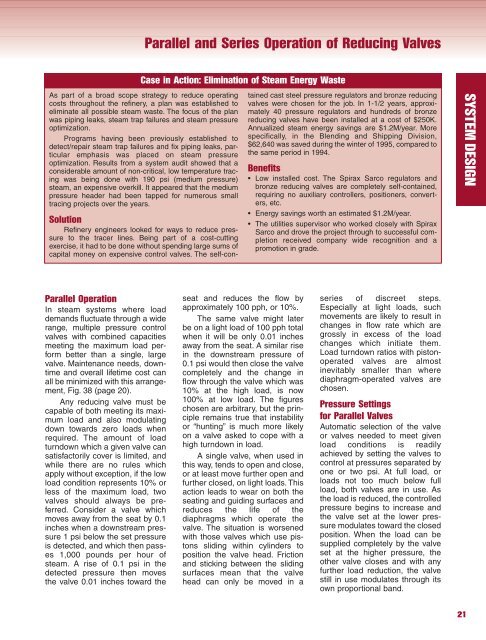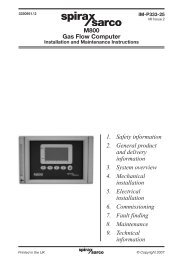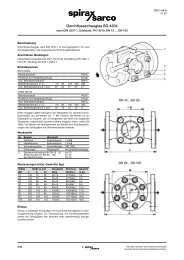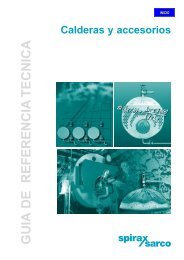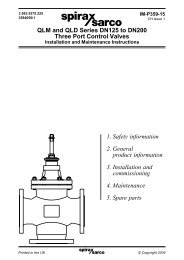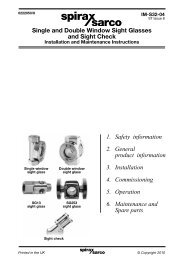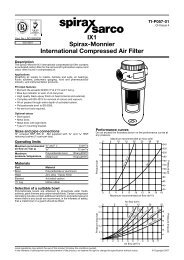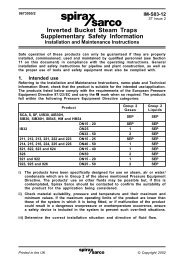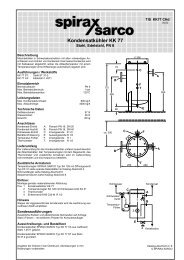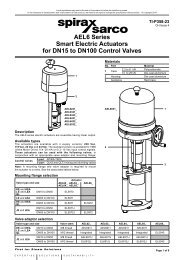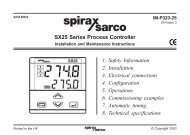2000 Hook-up Book - Spirax Sarco
2000 Hook-up Book - Spirax Sarco
2000 Hook-up Book - Spirax Sarco
Create successful ePaper yourself
Turn your PDF publications into a flip-book with our unique Google optimized e-Paper software.
Parallel Operation<br />
In steam systems where load<br />
demands fluctuate through a wide<br />
range, multiple pressure control<br />
valves with combined capacities<br />
meeting the maximum load perform<br />
better than a single, large<br />
valve. Maintenance needs, downtime<br />
and overall lifetime cost can<br />
all be minimized with this arrangement,<br />
Fig. 38 (page 20).<br />
Any reducing valve must be<br />
capable of both meeting its maximum<br />
load and also modulating<br />
down towards zero loads when<br />
required. The amount of load<br />
turndown which a given valve can<br />
satisfactorily cover is limited, and<br />
while there are no rules which<br />
apply without exception, if the low<br />
load condition represents 10% or<br />
less of the maximum load, two<br />
valves should always be preferred.<br />
Consider a valve which<br />
moves away from the seat by 0.1<br />
inches when a downstream pressure<br />
1 psi below the set pressure<br />
is detected, and which then passes<br />
1,000 pounds per hour of<br />
steam. A rise of 0.1 psi in the<br />
detected pressure then moves<br />
the valve 0.01 inches toward the<br />
Parallel and Series Operation of Reducing Valves<br />
Case in Action: Elimination of Steam Energy Waste<br />
As part of a broad scope strategy to reduce operating<br />
costs throughout the refinery, a plan was established to<br />
eliminate all possible steam waste. The focus of the plan<br />
was piping leaks, steam trap failures and steam pressure<br />
optimization.<br />
Programs having been previously established to<br />
detect/repair steam trap failures and fix piping leaks, particular<br />
emphasis was placed on steam pressure<br />
optimization. Results from a system audit showed that a<br />
considerable amount of non-critical, low temperature tracing<br />
was being done with 190 psi (medium pressure)<br />
steam, an expensive overkill. It appeared that the medium<br />
pressure header had been tapped for numerous small<br />
tracing projects over the years.<br />
Solution<br />
Refinery engineers looked for ways to reduce pressure<br />
to the tracer lines. Being part of a cost-cutting<br />
exercise, it had to be done without spending large sums of<br />
capital money on expensive control valves. The self-con-<br />
seat and reduces the flow by<br />
approximately 100 pph, or 10%.<br />
The same valve might later<br />
be on a light load of 100 pph total<br />
when it will be only 0.01 inches<br />
away from the seat. A similar rise<br />
in the downstream pressure of<br />
0.1 psi would then close the valve<br />
completely and the change in<br />
flow through the valve which was<br />
10% at the high load, is now<br />
100% at low load. The figures<br />
chosen are arbitrary, but the principle<br />
remains true that instability<br />
or “hunting” is much more likely<br />
on a valve asked to cope with a<br />
high turndown in load.<br />
A single valve, when used in<br />
this way, tends to open and close,<br />
or at least move further open and<br />
further closed, on light loads. This<br />
action leads to wear on both the<br />
seating and guiding surfaces and<br />
reduces the life of the<br />
diaphragms which operate the<br />
valve. The situation is worsened<br />
with those valves which use pistons<br />
sliding within cylinders to<br />
position the valve head. Friction<br />
and sticking between the sliding<br />
surfaces mean that the valve<br />
head can only be moved in a<br />
tained cast steel pressure regulators and bronze reducing<br />
valves were chosen for the job. In 1-1/2 years, approximately<br />
40 pressure regulators and hundreds of bronze<br />
reducing valves have been installed at a cost of $250K.<br />
Annualized steam energy savings are $1.2M/year. More<br />
specifically, in the Blending and Shipping Division,<br />
$62,640 was saved during the winter of 1995, compared to<br />
the same period in 1994.<br />
Benefits<br />
• Low installed cost. The <strong>Spirax</strong> <strong>Sarco</strong> regulators and<br />
bronze reducing valves are completely self-contained,<br />
requiring no auxiliary controllers, positioners, converters,<br />
etc.<br />
• Energy savings worth an estimated $1.2M/year.<br />
• The utilities s<strong>up</strong>ervisor who worked closely with <strong>Spirax</strong><br />
<strong>Sarco</strong> and drove the project through to successful completion<br />
received company wide recognition and a<br />
promotion in grade.<br />
series of discreet steps.<br />
Especially at light loads, such<br />
movements are likely to result in<br />
changes in flow rate which are<br />
grossly in excess of the load<br />
changes which initiate them.<br />
Load turndown ratios with pistonoperated<br />
valves are almost<br />
inevitably smaller than where<br />
diaphragm-operated valves are<br />
chosen.<br />
Pressure Settings<br />
for Parallel Valves<br />
Automatic selection of the valve<br />
or valves needed to meet given<br />
load conditions is readily<br />
achieved by setting the valves to<br />
control at pressures separated by<br />
one or two psi. At full load, or<br />
loads not too much below full<br />
load, both valves are in use. As<br />
the load is reduced, the controlled<br />
pressure begins to increase and<br />
the valve set at the lower pressure<br />
modulates toward the closed<br />
position. When the load can be<br />
s<strong>up</strong>plied completely by the valve<br />
set at the higher pressure, the<br />
other valve closes and with any<br />
further load reduction, the valve<br />
still in use modulates through its<br />
own proportional band.<br />
21<br />
SYSTEM DESIGN


